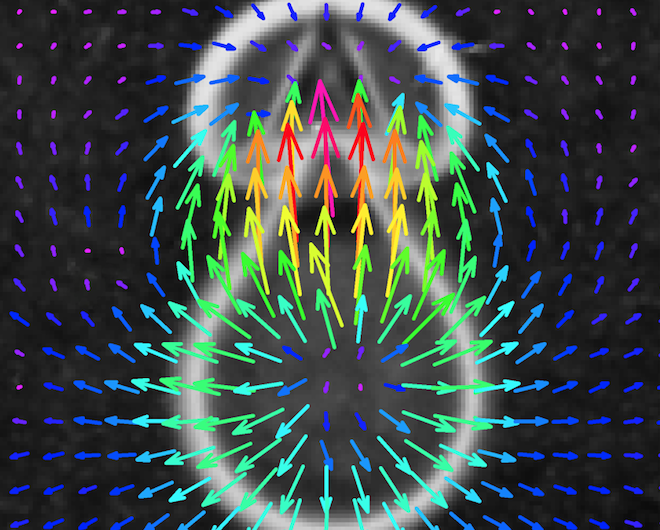New technique captures diverse effects of cavitation bubbles on individual cells

Duke researchers have devised a way to take an in-depth look at a poorly understood phenomenon that commonly occurs in medical procedures using therapeutic ultrasound, such as shattering kidney stones, delivering drugs to cells, and, most recently, breaking the blood-brain barrier.
When ultrasonic pressure waves move through a liquid, they can cause bubbles to form and oscillate rapidly around gaseous imperfections. If these so-called cavitation bubbles collapse very close to a boundary or the surface of another bubble, they can produce fast-moving jets to erupt in their wake. The phenomenon can be so powerful that it can cause severe damage to ship propellers.
Cavitation bubbles form as high-amplitude ultrasonic pressure waves travel through liquid. While commonly exploited in many medical procedures, their interactions with tissues are not clearly understood, especially at the cellular level.
Cavitation bubbles are also behind a recent finding from Sunnybrook Health Sciences Centre in Toronto in which a team successfully delivered cancer drugs through the blood-brain barrier of a patient.
In a new study, Duke researchers used high-speed, high-resolution cameras to reveal minute details of how cavitation bubbles affect nearby cells. The results appear online the week of Dec. 7, in the Proceedings of the National Academy of Sciences.
The effects of these powerful little bubbles on living cells "have long been a 'black box' where results are hard to predict and it is unknown why certain outcomes occur," said Pei Zhong, the Anderson-Rupp Professor of Mechanical Engineering and Materials Science at Duke. "We hope this new experimental system can provide much-needed mechanistic insights, which could help optimize therapeutic procedures and lead to new creative treatments."
Depending on the proximity of the bubbles, these jets can rapidly stretch nearby cells, poke holes in them or even obliterate their membranes. Understanding how different cells react to these jets will inform a wide variety of medical techniques, Zhong said.
"The experimental control and precision we have developed is unprecedented," said Zhong. "We have created a unique and versatile tool to study how cells respond to cavitation-induced shear flows. Future results providing mechanical characterizations of individual cells could be harnessed for disease diagnosis and treatment monitoring."
The new technique begins with a microfluidic chamber—a glass slide with a silicone channel that is filled with fluid. A laser pulse passes through the bottom of the glass slide and strikes the opposite side, which is covered in tiny gold dots near individual cells that are grown in patterned islands.
When the focused, pulsed laser strikes a gold dot, it vaporizes the surrounding fluid, causing a cavitation bubble to form. By creating two bubbles side-by-side at slightly different times, the researchers can control the direction of the resulting jet when the bubbles collapse.
In their experiments, Zhong and his team placed individual cells at different distances away from these jets to observe how they react to different levels of shear stress. The results have already yielded some interesting insights.
"Previous studies have shown that cell membranes can only withstand 3 percent increase in area strain before rupturing," said Zhong. "But these experiments stretched the membrane for a second or longer. Our results have shown that if the membrane is stretched for a millisecond or less, it can actually withstand strains an order of magnitude higher before a minute pore is formed. And importantly, small pores can reseal, allowing the target cell to fully recover. Observations such as these could open the door to new or improved therapies."
More information: Cell membrane deformation and bioeffects produced by tandem bubble-induced jetting flow, PNAS, www.pnas.org/cgi/doi/10.1073/pnas.1518679112
Journal information: Proceedings of the National Academy of Sciences
Provided by Duke University




















